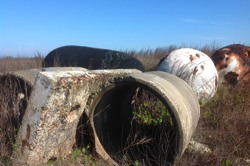HOME
TOPICS
ABOUT ME
Now you can get the closest thing to raw photos from a most unlikely source -- an iPad or iPhone.
Starting our fourth decade: Al Fasoldt's reviews and commentaries, continuously online for 30 years

'Raw' photos on an iPad or iPhone
March 16, 2014
By Al Fasoldt
Copyright © 2014, Al Fasoldt
Copyright © 2014, The Post-Standard
When I was a kid my favorite snack was a raw potato, cut into small slices and topped with salt. I didn't like cooked potatoes. Even as an 8-year-old, I must have known that raw was closer to the real thing than cooked.
Photographers are learning the same lesson. "Raw" photos, like raw potatoes, are closer to the real thing. A raw photo -- I'm dropping the quotation marks from now on -- is a picture that comes out of the camera without any alterations.
 Old remnants of a pier, taken by an iPad 3 using Pure Shot.
Old remnants of a pier, taken by an iPad 3 using Pure Shot.Click or tap the photo to see the raw original.
Pro cameras and a lot of semi-pro models use raw, but the rest of us probably have the cooked kind -- cameras that try to make up for weaknesses in the design of their sensors by tweaking here and boosting there each time a photo slides down the chute. This happens without your knowledge and can't be turned off. It happens inside, and isn't related to any of the settings you use when you take a picture.
Non-raw cameras do something else that causes problems: They funnel the pixels through a sort of compactor that crams them into a small space. Photos that go through this meat grinder, called JPEG, lose quality that can never be restored.
Raw photos fix all this. The camera is forced to keep its mitts off your pictures. The sensor -- that pixel-packing light-sensitive thing behind the lens -- is the sole star of this production. What the sensor sees is what you get.
Using software such as Picasa, iPhoto or of course Photoshop, you can then take the raw photo and massage it to correct anything that doesn't look right.
Raw cameras cost more than the ordinary kind. But now you can get the closest thing to raw photos from a most unlikely source -- an iPad or iPhone.
The results are incredible. The app that does this is called Pure Shot, from a company known as Jag.gr. It's at the App Store for $1.99. If you own an iPad or an iPhone (or even a camera-equipped iPod Touch) and you don't buy this, you're not awake.
Pure Shot, also called simply "Pure," is called a "no filter" app, meaning no tweaking is done. But that spells "raw" to me. The company avoids the usual "DNG" image format used for raw cameras, instead choosing TIFF. That's OK with me, since TIFFs avoid the JPEG problem, too.
Besides its raw features, the app has nearly all the high-end features of multi-megabuck cameras. Last week's column showed an incredible photo of Jupiter taken on an iPad with Pure Shot. This week's image is another example. (Look at both originals on my website, www.technofileonline.com.) This app changes my understanding of what the iPad can do, and it might change yours, too.
(Note: Other iPad and iPhone apps that take "unfiltered" photos have appeared recently. I'll report them later this year. I've seen no Android raw apps yet.)